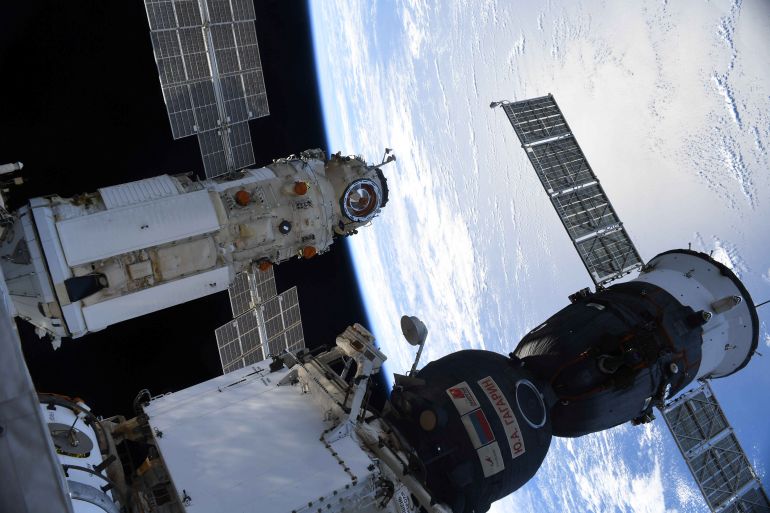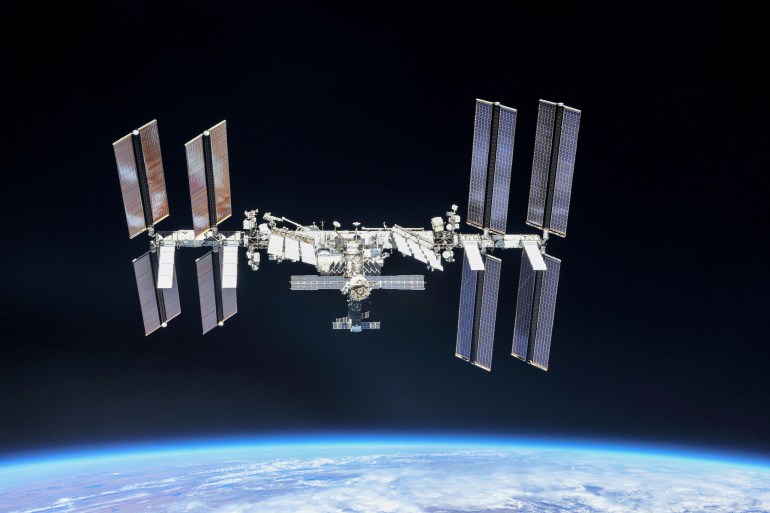Russian cosmonaut team arrives at the International Space Station
The blastoff marked the first space crew launch since Russia launched an invasion of Ukraine on February 24.

Three Russian cosmonauts safely arrived at the International Space Station (ISS), docking their Soyuz capsule with the outpost for a mission that continues a 20-year shared Russian-US presence in orbit despite tensions over Russia’s invasion of Ukraine.
The rendezvous came about three hours and 10 minutes after the Soyuz spacecraft carrying the new cosmonaut team lifted off from Russia’s Baikonur Cosmodrome in Kazakhstan on Friday.
Keep reading
list of 4 itemsBest of The Take: Billionaires’ space race
Elon Musk space rocket on collision course with the Moon
SpaceX satellites are tumbling out of orbit after solar storm
The docking, confirmed at 19:13 GMT, took place while the Soyuz and space station were flying about 420km (250 miles) over eastern Kazakhstan, according to NASA.
Soyuz commander Oleg Artemyev led the team, joined by two spaceflight rookies, Denis Matveev and Sergey Korsakov, on a science mission set to last 6.5 months.

The launch was carried live by NASA TV and on the US space agency’s website.
About 2.5 hours into the flight, the Soyuz became visible from the space station as a tiny black dot gradually growing larger as it came closer, the NASA webcast showed.
The three cosmonauts will join the station’s current seven-member crew to replace three who are scheduled to fly back to Earth on March 30 – cosmonauts Pyotr Dubrov and Anton Shkaplerov and US NASA astronaut Mark Vande Hei.
Remaining on board the ISS with the newcomers until the next rotation two months later are three NASA astronauts – Tom Marshburn, Raja Chari and Kayla Barron – and German crew mate Matthias Maurer of the European Space Agency.
Those four crew members arrived together in November on board a SpaceX Crew Dragon craft launched from NASA’s Kennedy Space Center in Florida to begin a six-month stint in orbit.
Launched in 1998, the research platform orbiting some 400km (250 miles) above Earth has been continuously occupied since November 2000 while operated by a US-Russian-led partnership including Canada, Japan and 11 European countries.
However, the war in Ukraine has resulted in cancelled spacecraft launches and broken contracts, and Roscosmos chief Dmitry Rogozin has warned that the US would have to use “broomsticks” to fly into space after Russia said it would stop supplying rocket engines to US companies.
Many worry that Rogozin is putting decades of a peaceful off-planet partnership at risk, most notably at the International Space Station.
NASA Administrator Bill Nelson played down Rogozin’s comments, telling The Associated Press news agency: “That’s just Dmitry Rogozin. He spouts off every now and then. But at the end of the day, he’s worked with us.
“The other people that work in the Russian civilian space programme, they’re professional. They don’t miss a beat with us, American astronauts and American mission control.”